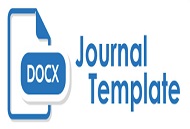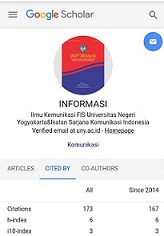Digital literacy among Sriwijaya University lecturers
DOI:
https://doi.org/10.21831/informasi.v47i2.15816Keywords:
eLearning, Digital Literacy, Higher Education, Indonesia, SriwijayaAbstract
This article aims to describe patterns of digital literacy among Sriwijaya University (SU) lecturer and its contribution to the implementation of eLearning. We used a mixed approach. Our population is 635 subjects who have been running and organizing through the e-learning plat-form of SU. We, then, selected 30 lecturers randomly as our samples. Data were collected through offline and online questionnaires, in-depth interviews, and secondary data collection. Likert Scale is used to measure digital literacy among respondents and e-learning implementation is explained using the SIMPLE model. We find that digital literacy competence among SU lecturers is in a high position. This situation is the initial capital for the implementation of e-learning at SU. However, this situation has not contributed to the implementation of e-learning because of (a) lecturer is not willing to adapt to the e-learning environment system; (b) policymakers have not been intervening several factors that contributed to e-learning implementation at the university level.
Artikel ini bertujuan menggambarkan pola literasi digital di kalangan dosen Universitas Sriwijaya dan kontribusinya terhadap implementasi e-learning. Artikel ini berasal dari penelitian empiris yang menggunakan pendekatan campuran (kualitatif dan kuantitatif). Populasi penelitian adalah 365 mata kuliah yang telah dijalankan dan diorganisir dengan platform e-learning yang diadopsi Universitas Sriwijaya. Dari populasi ini, peneliti memilih 30 dosen secara acak sebagai sampel penelitian. Data dikumpulkan dengan menggunakan kuesioner online dan offline, wawancara mendalam, dan pengumpulan data sekunder. Skala Likert digunakan untuk mengukur tingkat literasi digital responden
penelitian. Sedangkan implementasi e-learning dijelaskan dengan model SIMPEL. Kami menemukan bahwa tingkat literasi digital dosen Universitas Sriwijaya berada pada posisi yang tinggi. Situasi ini merupakan modal awal untuk mengimplementasikan e-learning di Universitas Sriwijaya. Tetapi, situasi ini belum berkontribusi terhadap implementasi e-learning karena (a) para dosen belum bersedia beradaptasi dengan lingkungan sistem e-learning; dan (b) para pembuat kebijakan belum mengintervensi beberapa faktor yang berkontribusi terhadap implementasi e-learning di level universitas.
References
ACRL. (2014). Introduction to Information Literacy | Association of College & Research Libraries (ACRL).
Al-Shboul, M. (2013). The level of E-learning integration at the University of Jordan: Challenges and opportunities. International Education Studies, 6(4), 93–113. http://doi.org/10.5539/ies.v6n4p93
Albion, P. R., Tondeur, J., Forkosh-Baruch, A., & Peeraer, J. (2015). Teachers' professional development for ICT integration: Towards a reciprocal relationship between research and practice. Education and Information Technologies, 20(4), 655–673. http://doi.org/10.1007/s10639-015-9401-9
Alvarenga, C. E. A., Ginestié, J., & Brandt-Pomares, P. (2016). How and why Brazilian and French teachers use learning objects. Education and Information Technologies, 1–28. http://doi.org/10.1007/s10639-016-9523-8
Bhatt, I., de Roock, R., & Adams, J. (2015). Diving deep into digital literacy: emerging methods for research. Language and Education, 29(6), 477–492. http://doi.org/10.1080/09500782.2015.1041972
Brumberger, E. (2011). Visual literacy and the digital native: an examination of the millenial learner. Journal of Visual Literacy, 30(1), 19–46.
Bryman, A. (2007). Effective leadership in higher education :a literature review. Studies in Higher Education, 32(6), 693–710. http://doi.org/10.1080/03075070701685114
Canhoto, A. I., & Murphy, J. (2016). Learning From Simulation Design to Develop Better Experiential Learning Initiatives. Journal of Marketing Education, 38(2), 98–106. http://doi.org/10.1177/0273475316643746
Crano, W. D., & Brewer, M. B. (2008). Principles and methods of social research (Second). London: Taylor & Francis eLibrary.
Davies, R. S. (2011). Understanding technology literacy: a framework for evaluating educational technology integration. TechTrends, 55(5), 45–52.
Edrees, M. E. (2014). eLearning X.0: International Journal of Technology Diffusion, 5(4), 1–13. http://doi.org/10.4018/ijtd.2014100101
Ensmenger, N. (2012). The Digital Construction of Technology: Rethinking the History of Computers in Society. Technology and Culture, 53(4), 753–776. http://doi.org/10.1353/tech.2012.0126
Erstad, O., Eickelmann, B., & Eichhorn, K. (2015). Preparing teachers for schooling in the digital age: A meta-perspective on existing strategies and future challenges. Education and Information Technologies, 20(4), 641–654. http://doi.org/10.1007/s10639-015-9431-3
Fearon, C., Starr, S., & McLaughlin, H. (2011). Value of blended learning in university and the workplace: some experiences of university students. Industrial and Commercial Training, 43, 446–450. http://doi.org/10.1108/00197851111171872
Gamire, E., & Pearson, G. (2006). Tech tally: approaches to assessing technological literacy. (E. Gamire & G. Pearson, Eds.)Literacy. Washington D.C., USA: The National Academics Press.
Greene, J. A., Yu, S. B., & Copeland, D. Z. (2014). Measuring critical components of digital literacy and their relationships with learning. Computers and Education, 76, 55–69. http://doi.org/10.1016/j.compedu.2014.03.008
Hockly, N. (2012). Digital literacies. ELT Journal: English Language Teachers Journal, 66(1), 108–112. http://doi.org/10.1093/elt/ccro77
Ilomäki, L., Paavola, S., Lakkala, M., & Kantosalo, A. (2014). Digital competence–an emergent boundary concept for policy and educational research. Education and Information Technologies, 21(3), 655–679. http://doi.org/10.1007/s10639-014-9346-4
Jaeger, P. T., Bertot, J. C., Thompson, K. M., Katz, S. M., & DeCoster, E. J. (2012). The Intersection of Public Policy and Public Access: Digital Divides, Digital Literacy, Digital Inclusion, and Public Libraries. Public Library Quarterly, 31(1), 1–20. http://doi.org/10.1080/01616846.2012.654728
Keane, T., Keane, W., & Blicblau, A. (2014). Beyond traditional literacy: Learning and transformative practices using ICT. Education and Information Technologies, 1–13. http://doi.org/10.1007/s10639-014-9353-5
Koltay, T. (2011). Information Overload, Information Architecture and Digital Literacy. Bulletin of the American Society for Information Science and Technology, 38(1), 33–35.
Kong, S. C., Chan, T.-W., Huang, R., & Cheah, H. M. (2014). A review of e-Learning policy in school education in Singapore, Hong Kong, Taiwan, and Beijing: implications to future policy planning. Journal of Computers in Education, 1(2–3), 187–212. http://doi.org/10.1007/s40692-014-0011-0
Marczyk, G., DeMatteo, D., & Festinger, D. (2005). Essential of research design and methodology. New Jersey: John Wiley & Sons, Inc.
Meyers, E. M., Erickson, I., & Small, R. V. (2013). Digital literacy and informal learning environments: an introduction. Learning, Media and Technology, 38(4), 355–367. http://doi.org/10.1080/17439884.2013.783597
Middlehurst, R., Education, H., & Woodfield, S. (2009). Why Research Leadership in Higher Education? Exploring Contributions from the UK's Leadership Foundation for Higher Education. Leadership, 5(3), 311–329. http://doi.org/10.1177/1742715009337763
Mirriahi, N., Alonzo, D., & Fox, B. (2015). A blended learning framework for curriculum design and professional development. Research in Learning Technology, 23(1), 28451. http://doi.org/10.3402/rlt.v23.28451
OED. (2014). literacy, n. : Oxford English Dictionary.
Pons, J. de P. (2010). Higher education and the knowledge society, information and digital competencies. RUSC: Universities and Knowledge Society Journal, 7(2), 6–15.
Radovanović, D., Hogan, B., & Lalić, D. (2015). Overcoming digital divides in higher education: Digital literacy beyond Facebook. New Media & Society, 17(10), 1733–1749. http://doi.org/10.1177/1461444815588323
Riis, S. (2015). ICT Literacy: An Imperative of the Twenty-First Century. Foundations of Science, 1–10. http://doi.org/10.1007/s10699-015-9456-5
Ritchie, J., & Spencer, L. (1994). Qualitative data analysis for applied policy research. In A. Bryman & R. G. Burgess (Eds.), Analyzing Qualitative Data (pp. 173–194). London: Sage Publication, Inc.
Rowsell, J., Burke, A., Flewitt, R., Liao, H., Lin, A., Marsh, J., ... Wohlwend, K. (2016). Humanizing Digital Literacies: A Road Trip in Search of Wisdom and Insight. The Reading Teacher, 70(1), 121–129. http://doi.org/10.1002/trtr.1501
Smith, S. (2015). Supporting Digital Literacy Across The Curriculum Through Blended Support: A Pilot Project Report. Journal Educational Technology Systems, 43(2), 189–198. Smith, Z. A., &
Wolverton, M. (2010). Higher Education Leadership Competencies: Quantitatively Refining a Qualitative Model. Journal of Leadership & Organizational Studies, 17(1), 61–70. http://doi.org/10.1177/1548051809348018
Sparks, J. R., Katz, I. R., & Beile, P. M. (2016). Assessing Digital Information Literacy in Higher Education: A Review of Existing Frameworks and Assessments With Recommendations for Next-Generation Assessment. ETS Research Report Series, 2016(2), 1–33. http://doi.org/10.1002/ets2.12118
Steffens, K., Bannan, B., Dalgarno, B., Bartolomé, A. R., Esteve-González, V., & Cela-ranilla, J. M. (2015). Recent Developments in Technology-Enhanced Learning: A Critical Assessment. RUSC. Universities and Knowledge Society JournalUniversities and Knowledge Society Journal, 12(2), 73–86. http://doi.org/10.7238/ rusc.v12i2.2453
Turner, B. S. (2007). Religious Authority and the New Media. Theory, Culture & Society, 24(2), 117–134. http://doi.org/10.1177/0263276407075001
Unsri. (2014). Moodle E-Learning for Sriwijaya Student (MoDELss).
van Heffen, O., & Aschheim, S. (2003). Cultural theory revised: Only five cultures or more? Contemporary Political Theory, 2(3), 289–306. http://doi.org/10.1057/palgrave.cpt.9300094
Vlieghe, J. (2015). ICT Literacy: A Technical or Non-technical Issue? Foundations of Science, 1–4. http://doi.org/10.1007/s10699-015-9458-3
Wilmes, B., Huffman, S., & Rickman, W. (2008). Transitioning from a Traditional Classroom to the Online Environment: The SIMPLE Model. In R. Z. Zheng & S. P. Ferris (Eds.), Understanding Online Instructional Modeling: Theories and Practices (pp. 126–134). Hershey, Philadelphia, USA: Information Science Reference.
Downloads
Published
How to Cite
Issue
Section
Citation Check
License
Authors who publish with this journal agree to the following terms:
- Authors retain copyright and grant the journal right of first publication with the work simultaneously licensed under a Creative Commons Attribution License that allows others to share the work with an acknowledgement of the work's authorship and initial publication in this journal.
- Authors are able to enter into separate, additional contractual arrangements for the non-exclusive distribution of the journal's published version of the work (e.g., post it to an institutional repository or publish it in a book), with an acknowledgement of its initial publication in this journal.
- Authors are permitted and encouraged to post their work online (e.g., in institutional repositories or on their website) prior to and during the submission process, as it can lead to productive exchanges, as well as earlier and greater citation of published work (See The Effect of Open Access).












